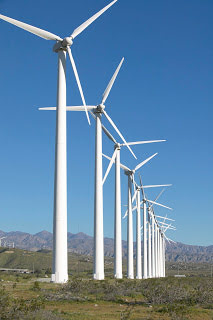New IRS guidance for developers of wind farms and other renewable energy projects that qualify for production tax credits modifies the safe harbor period in which a project can be placed in service without the developer having to prove that the work was continuous.
The new rule provides that a project will be deemed to meet the continuous work requirement if it is placed in service by the later of (1) four calendar years after the calendar year in which construction began, or (2) December 31, 2016.
The guidance is in Notice 2016-31. It was originally issued on May 5, 2016, and included only the four-year safe harbor rule. The IRS reissued the guidance on May 18, 2106 to add the alternative December 31, 2016 deadline. The updated guidance also corrects a math error in an example in the original guidance, and states that it is effective for projects placed in service after January 2, 2013.
The revisions to Notice 2016-31 are only beneficial for a small subset of projects that began construction prior to January 1, 2012 and that can be completed within the next six and a half months. A 2012 project that cannot be completed until 2017 is out of luck.
Developers must begin construction by the end of 2016 in order to qualify for the full amount of production tax credits. The credits phase down for facilities that begin construction after 2016. The credit amount is reduced to 80% for projects that begin construction in 2017, 60% for projects that begin construction in 2018, and 40% for projects that begin construction in 2019. No credits are available for projects that begin construction in 2020 or later.
Notice 2016-31 is the latest in a series of IRS notices that provide guidelines to determine when construction on a facility has begun. There are two alternative tests: a physical work test, where the developer must show that it began physical work of a significant nature, and a safe harbor test, in which the developer must show that it paid or incurred at least five percent of the total cost of the facility. Both methods require the developer to make continuous progress towards completion once construction has begun. Continuous progress is determined based on the particular facts and circumstances of the project.
The IRS created a safe harbor for the continuous progress requirement in Notice 2013-60, which provides that the test was deemed satisfied if the facility was placed in service by January 1, 2016. The deadline was extended to January 1, 2017 by subsequent IRS guidance to mirror Congress’ one-year extension of the start of construction deadline for production tax credits at the end of 2014.
Notice 2016-31 builds off of the prior guidance by establishing a new “continuity safe harbor.” If Developers cannot place a wind farm in service by the end of 2016, the safe harbor gives them four years from the end of the calendar year that construction began to place it in service without having to prove continuous work. Projects that cannot meet the new safe harbor deadline have to prove continuous work based on facts and circumstances.
Unlike the old safe harbor, the four year clock does not start at the end of the construction start deadline for the full amount of production tax credits. Rather, the IRS requires the parties to look back to the year construction started, which could be as early as 2013 for projects that rushed to start construction to meet earlier start of construction deadlines (and possibly even earlier if the test was satisfied inadvertently).
Unless it is clear that a project will be completed by the end of 2016, the key question from tax equity and construction lenders will be “what is the earliest possible point that you may have begun construction?”
To think about this in context, a developer should ask itself when the earliest date was that any physical work was completed with respect to the project, and when the earliest date was that any equipment was purchased for the project (including equipment purchased for cancelled projects that will be incorporated into this project).
Many developers began physical work in 2013 for the purpose of satisfying the then-existing requirement to start construction prior to January 1, 2014. These developers were not yet in a position to build the entire project, but were taking the necessary steps to ensure that their project would qualify for the production tax credit or investment tax credit. Existing IRS guidance gave them two years to build the project without having to prove continuous construction, and they were working towards that end. They ended up getting more time as a result of the one-year extension of the start of construction deadline at the end of 2014, followed by the current extension that was enacted at the end of 2015. Many of these developers assumed that the IRS would extend the existing two-year safe harbor for continuous work through the end of 2018, but instead were surprised by this new rule which retroactively started a four-year clock from the year that construction began. In most cases, these developers will need to accelerate their projects to ensure completion by the end of 2017 if they are concerned about satisfying the continuous construction requirement. However, for projects that are completed after 2016 that began physical work in 2012 or earlier, these rules may result in projects failing to qualify for tax credits, which is a serious and unexpected consequence of the new rules.
A separate set of guidance for solar projects is expected later this year.
How to satisfy the new begun construction guidance in IRS Notice 2016-31
Posted in Renewable energy Blog article


